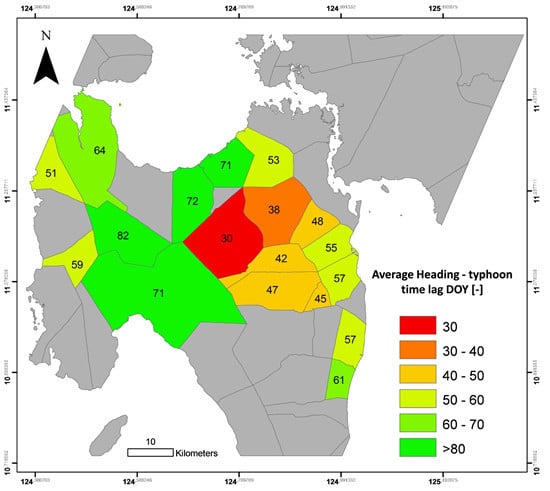Rapid Assessment of Crop Status: An Application of MODIS and SAR Data to Rice Areas in Leyte, Philippines Affected by Typhoon Haiyan
Abstract
:1. Introduction
1.1. Rice Crops in Asia and Their Exposure to Tropical Storms
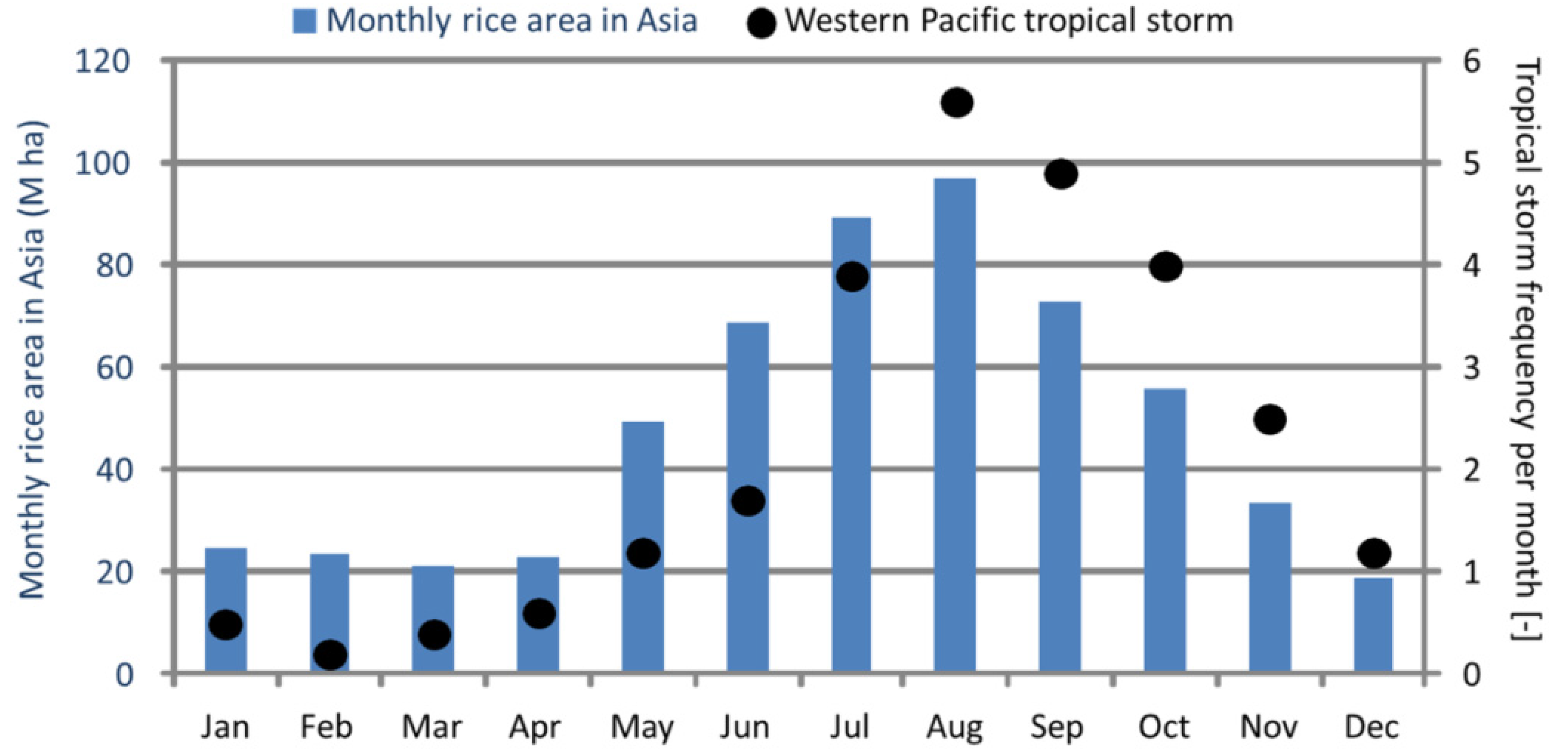
1.2. Typhoon Haiyan and Its Impact in Philippines
1.3. Assessing the Risk of Crop Damage and Actual Crop Damage from Tropical Storms
1.4. Remote Sensing as a Source of Unbiased and Timely Information on Crop and Vegetation Status

1.5. A Remote Sensing-based Proposal for a Proactive Approach on Rice Crop Status Assessment
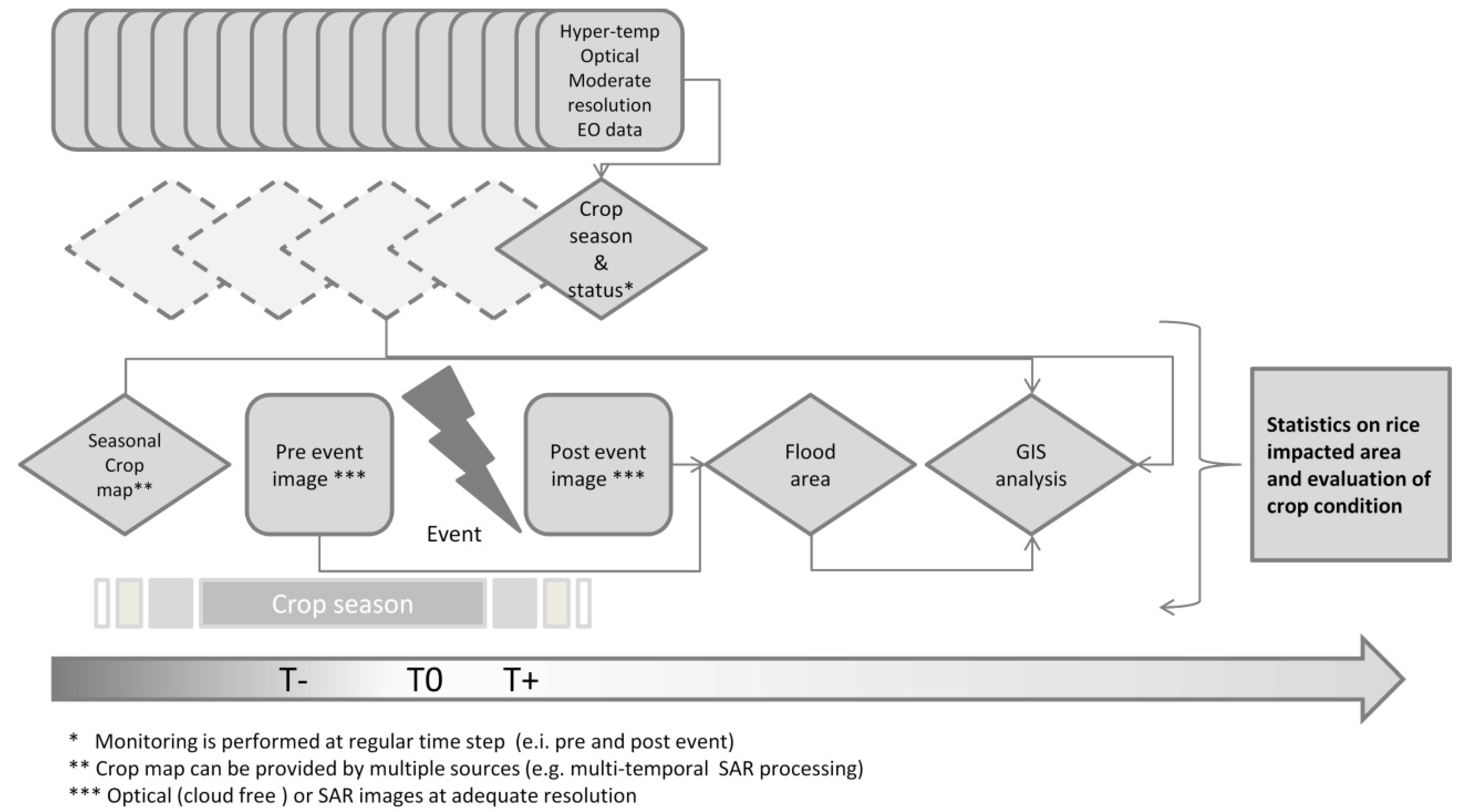
2. Study Site and Data
2.1. Leyte Province and Its Rice Production Systems
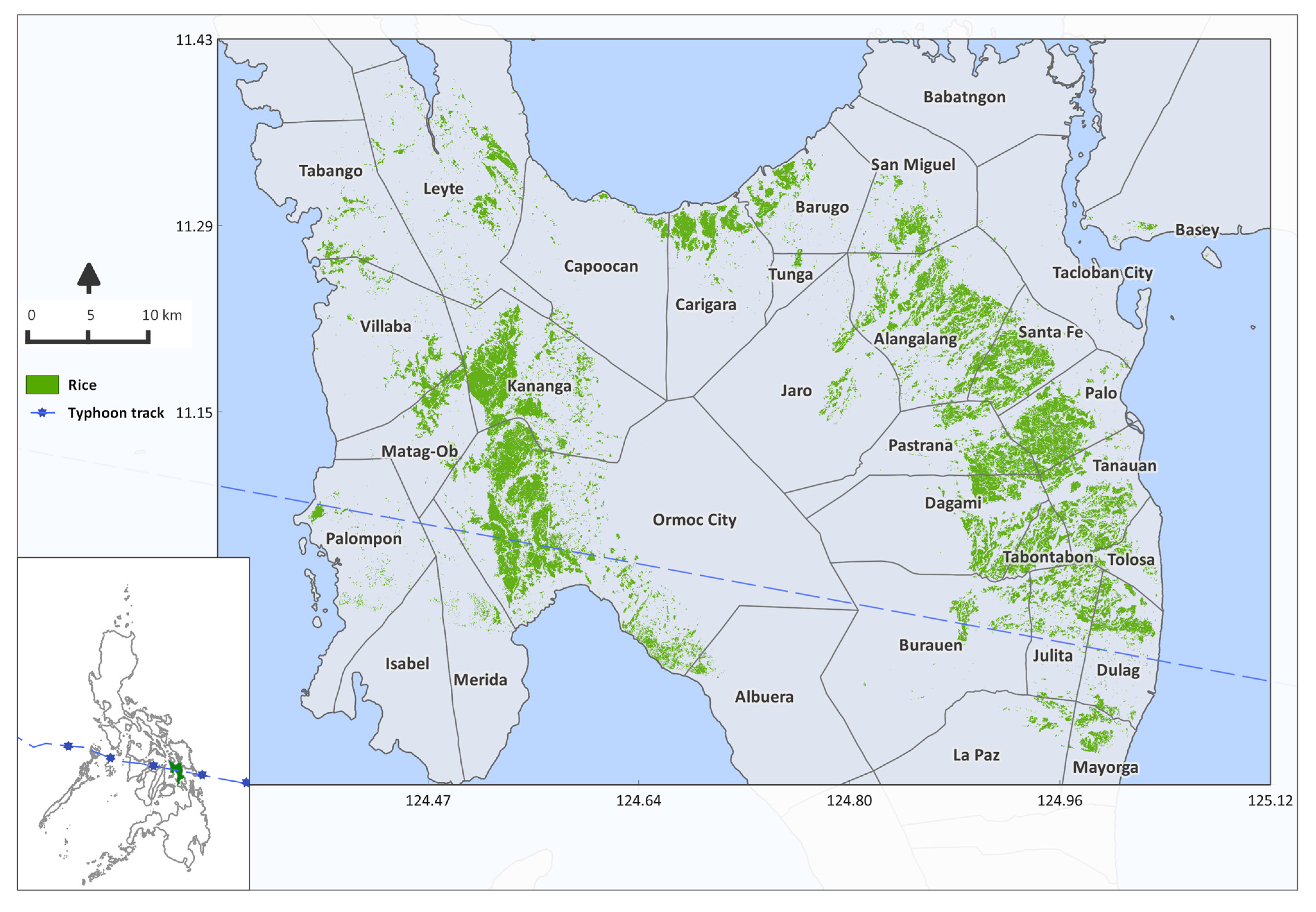
2.2. Remote Sensing Data
| Location | Northwest Leyte | Northeast Leyte | Northeast Leyte | Leyte | |
|---|---|---|---|---|---|
| Purpose | Rice area map | Rice area map | Flooded area detection | Rice crop status | |
| Satellite or instrument | Cosmo-SkyMed (CSK 1, 3 and 4) | Cosmo-SkyMed (CSK 1 and 4) | Cosmo-SkyMed (CSK 1 and 2) | Terra and Aqua | |
| Sensor mode | Stripmap | Stripmap | Stripmap | MODIS | |
| Product | SLC | SLC | SLC | MOD13Q1 and MYD13Q1 | |
| Band | X (3.12 cm) | X (3.12 cm) | X (3.12 cm) | Red (620–670 nm), NIR (841–876 nm), Blue (459–479 nm) | |
| Resolution (m) | 3 | 3 | 3 | 250 | |
| Swath (km) | 40 × 40 | 40 × 40 | 40 × 40 | 40 × 40 | 1200 × 1200 |
| Scene center | 11.18°N 124.56°E | 11.11°N 124.89°E | 11.11°N 124.89°E | 11.08°N 124.93°E | 14.9° N 129.41° E |
| Polarization | HH | HH | HH | HH | - |
| Look | Right | Right | Right | Right | - |
| Orbit | Descending | Descending | Descending | Descending | Descending |
| Incidence angle | 48 | 46 | 46 | 54 | - |
| Cycle (days) | 16 | 16 | - | - | 16 (8) |
| Start day | 12 May 2013 | 15 May 2013 | 20 September 2013 | 8 November 2013 | 6 December 2012 |
| End day | 24 September 2013 | 20 September 2013 | 11 November 2013 | 16 November 2013 | 11 December 2013 |
| Images | 9 | 10 | 2 | 2 | 70 |
2.3. Field Data and Additional Spatial Information
3. Methods
3.1. Proactive Assessment of Rice Crop Status and Risk of Damage
3.1.1. Rice Crop Mask from SAR Data
3.1.2. MODIS Data Pre-Processing
3.1.3. Phenological Metric Extraction from Smoothed MODIS Times Series Data
- i)
- located between 56 and 120 days after the estimated transplanting date, based on known durations of vegetative stages of rice crops grown in this area and season;
- ii)
- showing an EVI value greater than 0.4; and
- iii)
- followed by a rapid reduction of EVI (a decrease of 1/3 of max-EVI value within 40 days) following [21].
3.1.4. Spatial and Statistical Analysis of the Phenology Metrics
3.1.5. Indicator of Risk of Standing Rice Crop Loss from a Typhoon
3.2. Reactive Assessment of Rice Crop Damage
- σ0 value for the flooded date (i.e., 11 or 8 November) is less than −13 dB; this value is associated with surface water for X-band, HH data at this incidence angle as described in [22].
- σ0 ratio between the reference or non-flooded images and the corresponding flooded acquisitions, is larger than 2.0; this represents a strong backscatter decrease over a short period of time that is not consistent with normal rice crop practices in this region and season.
4. Results and Discussion
4.1. Example Rice Crop Phenological Stages from MODIS Time Series Data
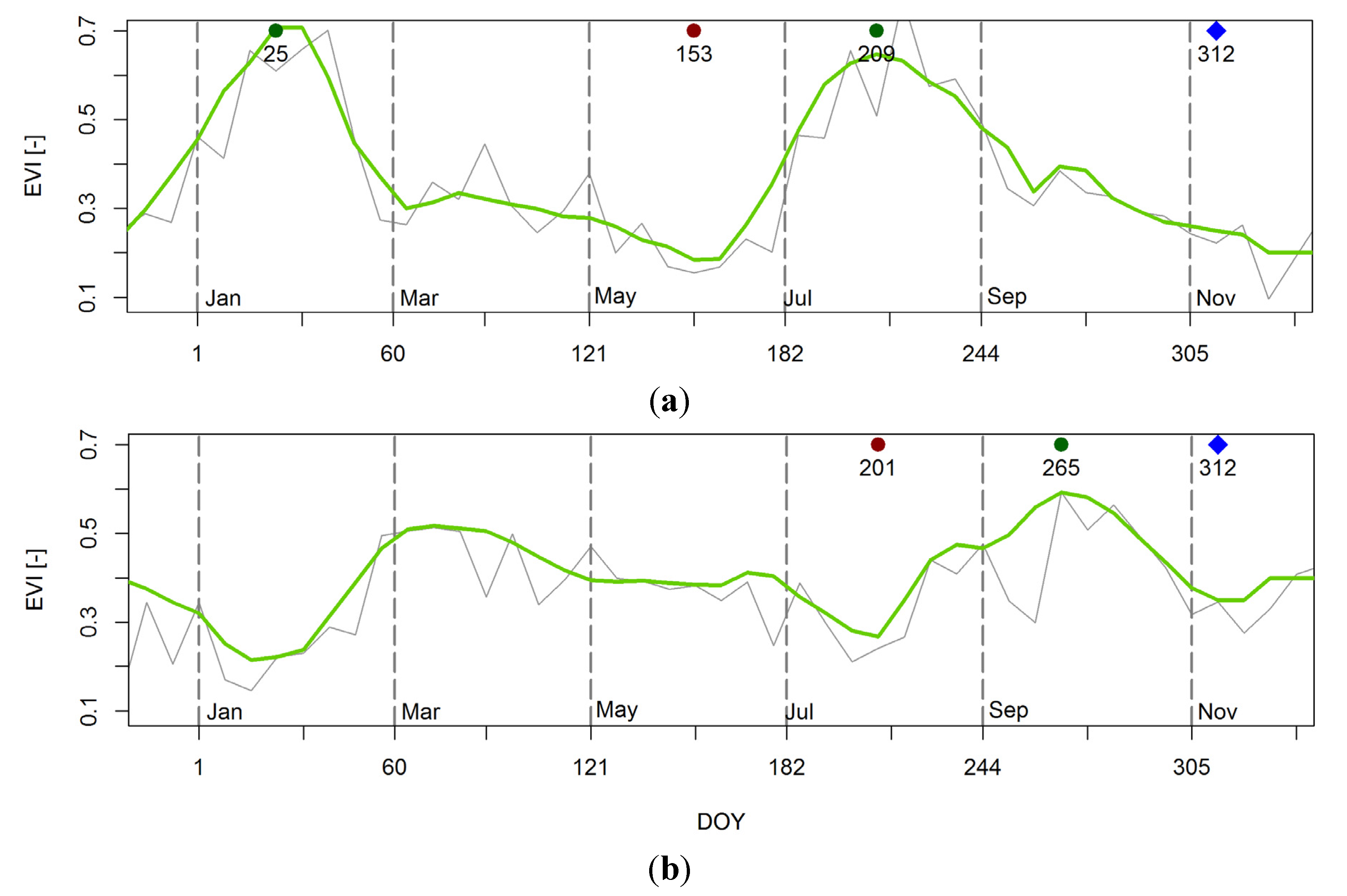
4.2. Analysis of Detection Rate

4.3. Analysis of Transplanting and Heading Date Accuracy
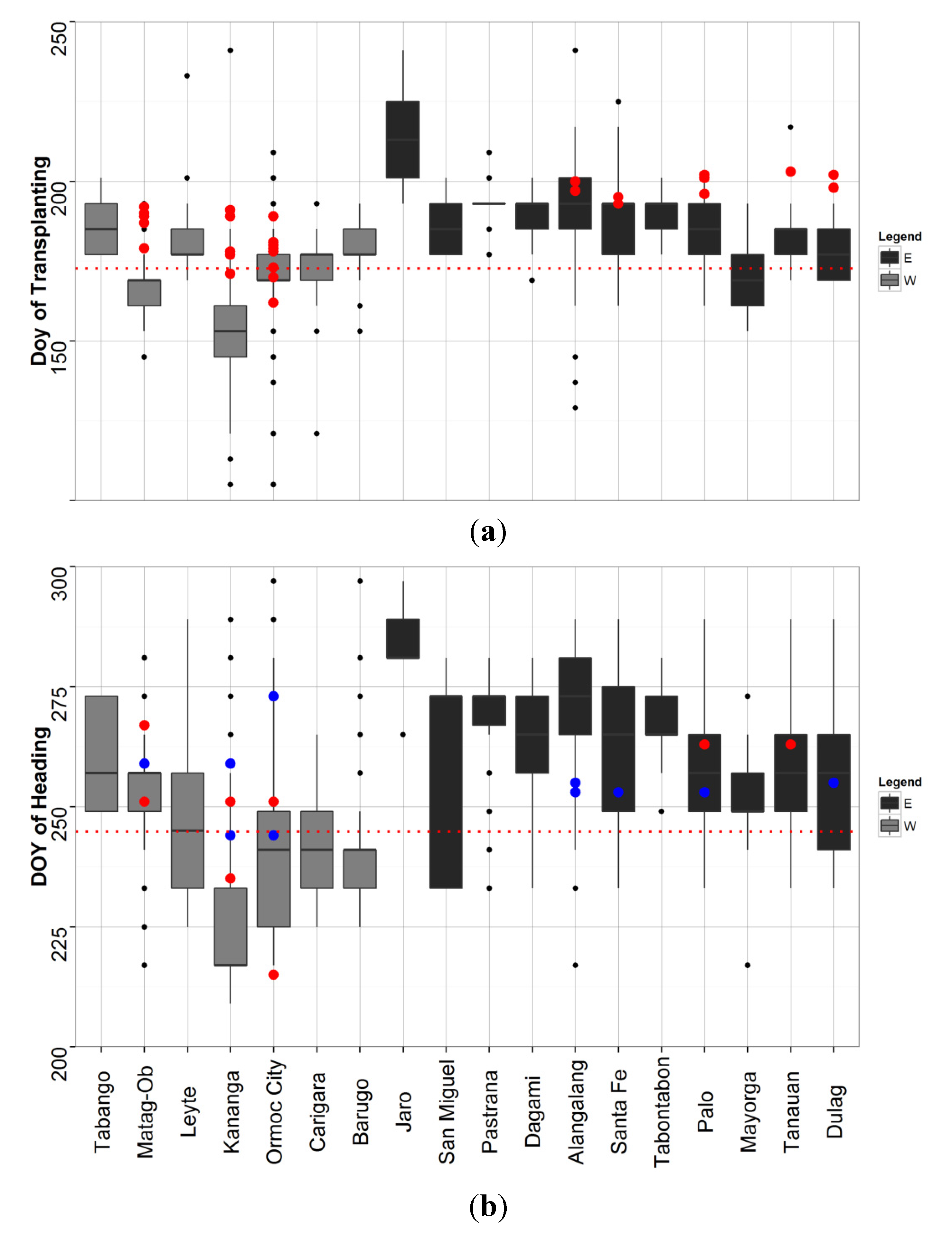
4.4. Standing Crop Area at Risk
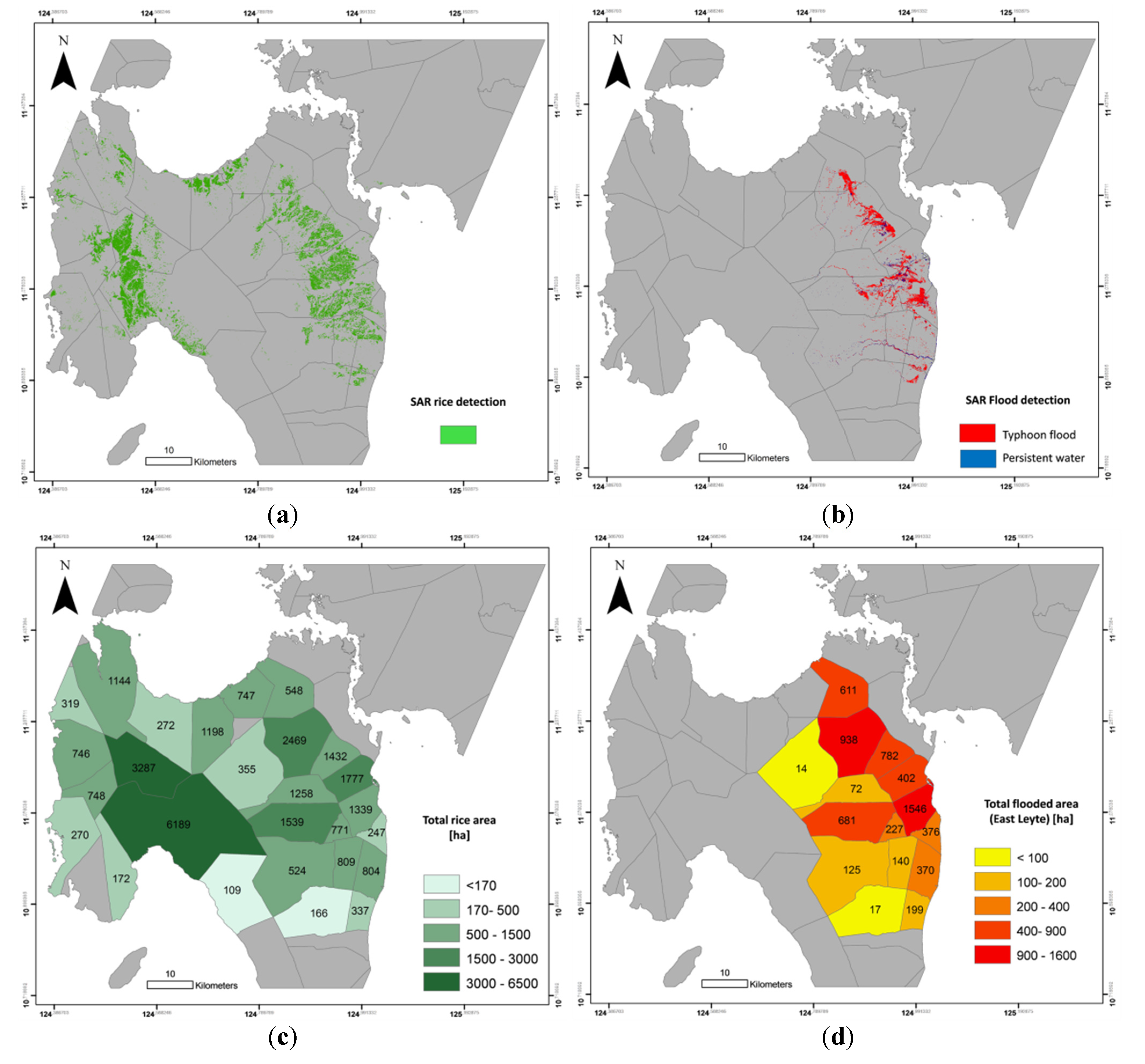
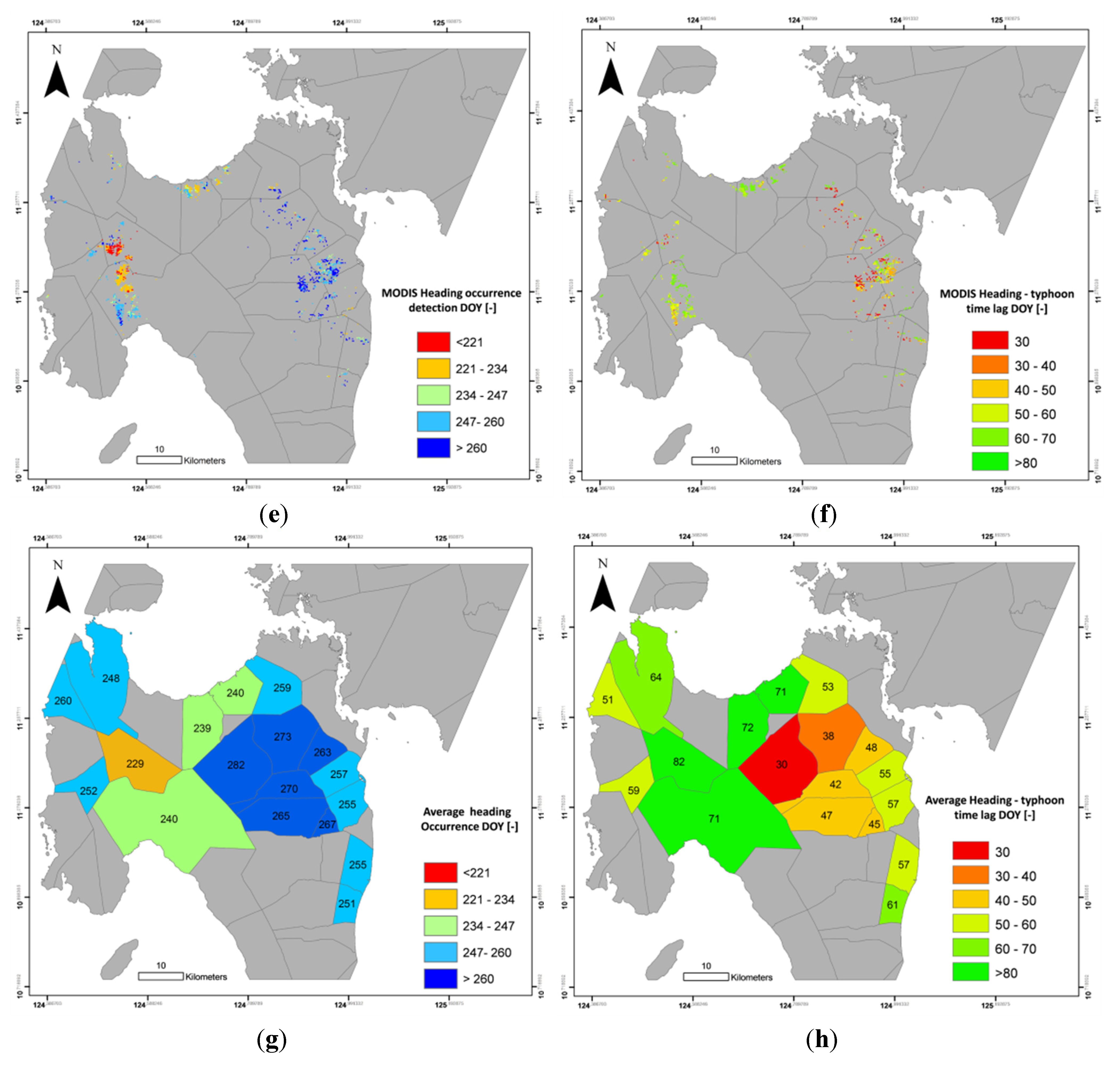
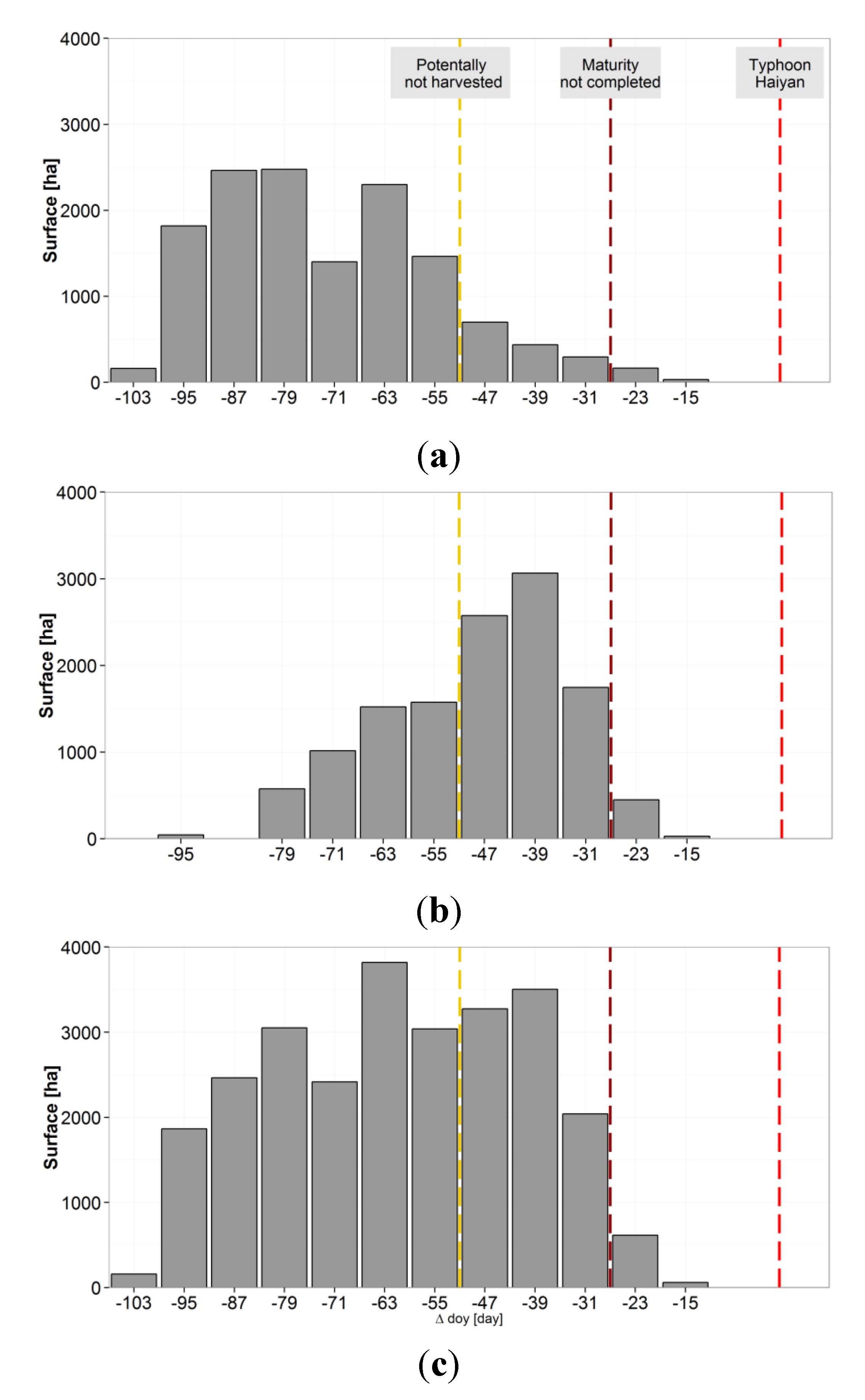
4.5. A Proposal for an Operational Monitoring System
5. Conclusions
- i)
- Can provide automatic phenological estimation using vegetation index time series derived from MODIS for a representative sample of MODIS pixels.
- ii)
- Is conservative yet captures rice crop status information on an area that is proportional to the rice area.
- iii)
- Can highlight spatial differences in agricultural practices and plant development.
- iv)
- Can be used to monitor the crop in-season and provide timely information on rice crop status.
Acknowledgments
Author Contributions
Conflicts of Interest
References
- Global Rice Science Partnership (GRiSP). Rice Almanac, 4th ed.; International Rice Research Institute: Los Banos, Philippines, 2013; p. 283. [Google Scholar]
- Statistics Division of the Food and Agriculture Organization of the United Nations (FAOSTAT). Avaliable online: http://faostat3.fao.org/faostat-gateway/go/to/home/E (accessed on 16 March 2015).
- Angove, M.D.; Falvey, R.J. Annual Tropical Cyclone Report 2011; Joint Typhoon Warning Center: Pearl Harbor, HI, USA, 2011. [Google Scholar]
- National Disaster Reduction and Risk Management Council (NDRRMC). NDRRMC Update: Site Rep No. 104 Effects of Typhoon “Yolanda” (HAIYAN). Avaliable online: www.ndrrmc.gov.ph (accessed on 16 March 2015).
- Brivio, P.A.; Colombo, R.; Maggi, M.; Tomasoni, R. Integration of remote sensing data and GIS for accurate mapping of flooded areas. Int. J. Remote Sens. 2002, 23, 429–441. [Google Scholar] [CrossRef]
- Schnebele, E.; Cervone, G.; Waters, N. Road assessment after flood events using non-authoritative data. Nat. Hazards Earth Syst. Sci. 2014, 14, 1007–1015. [Google Scholar] [CrossRef]
- Lee, M.-F.; Lin, T.-C.; Vadeboncoeur, M.A.; Hwong, J.-L. Remote sensing assessment of forest damage in relation to the 1996 strong typhoon Herb at Lienhuachi Experimental Forest, Taiwan. For. Ecol. Manag. 2008, 255, 3297–3306. [Google Scholar] [CrossRef]
- Sanyal, J.; Lu, X.X. Application of Remote Sensing in Flood Management with Special Reference to Monsoon Asia: A Review. Nat. Hazards 2004, 33, 283–301. [Google Scholar] [CrossRef]
- Chau, V.N.; Holland, J.; Cassells, S.; Tuohy, M. Using GIS to map impacts upon agriculture from extreme floods in Vietnam. Appl. Geogr. 2013, 41, 65–74. [Google Scholar] [CrossRef]
- Dahdouh-Guebas, F.; Jayatissa, L.P.; di Nitto, D.; Bosire, J.O.; Lo Seen, D.; Koedam, N. How effective were mangroves as a defence against the recent tsunami? Curr. Biol. 2005, 15, R443–R447. [Google Scholar] [CrossRef] [PubMed]
- Kamthonkiat, D.; Rodfai, C.; Saiwanrungkul, A.; Koshimura, S.; Matsuoka, M. Geoinformatics in mangrove monitoring: damage and recovery after the 2004 Indian Ocean tsunami in Phang Nga, Thailand. Nat. Hazards Earth Syst. Sci. 2011, 11, 1851–1862. [Google Scholar] [CrossRef]
- Belward, A.S.; Stibig, H.J.; Eva, H.; Rembold, F.; Bucha, T.; Hartley, A.; Beuchle, R.; Khudhairy, D.; Michielon, M.; Mollicone, D. Mapping severe damage to land cover following the 2004 Indian Ocean tsunami using moderate spatial resolution satellite imagery. Int. J. Remote Sens. 2007, 28, 2977–2994. [Google Scholar] [CrossRef]
- Chen, P.; Liew, S.C.; Kwoh, L.K. Tsunami damage assessment using high resolution satellite imagery: a case study of Aceh, Indonesia. In Proceedings of the 2005 IEEE International Geoscience and Remote Sensing Symposium, Seoul, Korea, 25–29 July 2005; pp. 1405–1408.
- Römer, H.; Kaiser, G.; Sterr, H.; Ludwig, R. Using remote sensing to assess tsunami-induced impacts on coastal forest ecosystems at the Andaman Sea coast of Thailand. Nat. Hazards Earth Syst. Sci. 2010, 10, 729–745. [Google Scholar] [CrossRef]
- Römer, H.; Jeewarongkakul, J.; Kaiser, G.; Ludwig, R.; Sterr, H. Monitoring post-tsunami vegetation recovery in Phang-Nga province, Thailand, based on IKONOS imagery and field investigations—A contribution to the analysis of tsunami vulnerability of coastal ecosystems. Int. J. Remote Sens. 2011, 33, 3090–30121. [Google Scholar] [CrossRef]
- Sirikulchayanon, P.; Sun, W.; Oyana, T.J. Assessing the impact of the 2004 tsunami on mangroves using remote sensing and GIS techniques. Int. J. Remote Sens. 2008, 29, 3553–3576. [Google Scholar] [CrossRef]
- Villa, P.; Boschetti, M.; Morse, J.L.; Politte, N. A multitemporal analysis of tsunami impact on coastal vegetation using remote sensing: a case study on Koh Phra Thong Island, Thailand. Nat. Hazards 2012, 64, 667–689. [Google Scholar] [CrossRef]
- FAO/Philippines Crop damages after Typhoon Haiyan in the Philippines. Available online: http://www.fao.org/emergencies/crisis/philippines-typhoon-haiyan/crop-damages-map/en/ (accessed on 15 March 2015).
- Holecz, F.; Barbieri, M.; Collivignarelli; Francesco; Gatti, L.; Nelson, A.; Setiyono, T.D.; Boschetti, M.; Manfron, G.; Brivio, P.A.; et al. An operational remote sensing based service for rice production estimation at national scale. In Proceedings of ESA Living Planet Symposium, Edinburgh, UK, 9–11 September 2013.
- Boschetti, M.; Stroppiana, D.; Brivio, P.A.; Bocchi, S. Multi-year monitoring of rice crop phenology through time series analysis of MODIS images. Int. J. Remote Sens. 2009, 30, 4643–4662. [Google Scholar] [CrossRef]
- Manfron, G.; Crema, A.; Boschetti, M.; Confalonieri, R. Testing automatic procedures to map rice area and detect phenological crop information exploiting time series analysis of remote sensed MODIS data. Proc. SPIE 2012, 8531, 85311E:1–85311E:11. [Google Scholar]
- Nelson, A.; Setiyono, T.; Rala, A.; Quicho, E.; Raviz, J.; Abonete, P.; Maunahan, A.; Garcia, C.; Bhatti, H.; Villano, L.; et al. Towards an operational SAR-based rice monitoring system in Asia: Examples from 13 demonstration sites across Asia in the RIICE Project. Remote Sens. 2014, 6, 10773–10812. [Google Scholar]
- National Statistical Coordination Board (NSCB). 2012 Full Year Official Poverty Statistics. Available online: www.nscb.gov.ph (accessed on 16 March 2015).
- Philippine Statistical Authority CountrySTAT. Available online: http://countrystat.bas.gov.ph/ (accessed on 16 March 2015).
- Land Processes Distributed Active Archive Centre (LP DAAC). Available online: http://e4ftl01.cr.usgs.gov/ (accessed on January 2015).
- Von Grebmer, K.; Ringler, C.; Rosegrant, M.W.; Olofinbiyi, T.; Wiesmann, D.; Fritschel, H.; Badiane, O.; Torero, M.; Yohannes, Y.; Thompson, J.; et al. 2012 Global Hunger Index | International Food Policy Research Institute (IFPRI). Available online: http://www.ifpri.org/publication/2012-global-hunger-index (accessed on 16 March 2015).
- Global Administrative Areas Database (GADM). Available online: http://www.gadm.org/ (accessed on 18 May 2015).
- Boschetti, M.; Nelson, A.; Manfrom, G.; Brivio, P.A. An automatic approach for rice mapping in temperate region using time series of MODIS imagery: First results for Mediterranean environment. EGU Geophys. Res. Abstr. 2012, 14, EGU2012-14068-1. [Google Scholar]
- Huete, A.; Didan, K.; Miura, T.; Rodriguez, E.P.; Gao, X.; Ferreira, L.G. Overview of the radiometric and biophysical performance of the MODIS vegetation indices. Remote Sens. Environ. 2002, 83, 195–213. [Google Scholar] [CrossRef]
- Jönsson, P.; Eklundh, L. TIMESAT—A program for analyzing time-series of satellite sensor data. Comput. Geosci. 2004, 30, 833–845. [Google Scholar] [CrossRef]
- Chen, J.; Jönsson, P.; Tamura, M.; Gu, Z.; Matsushita, B.; Eklundh, L. A simple method for reconstructing a high-quality NDVI time-series data set based on the Savitzky–Golay filter. Remote Sens. Environ. 2004, 91, 332–344. [Google Scholar] [CrossRef]
- White, M.A.; Nemani, R.R. Real-time monitoring and short-term forecasting of land surface phenology. Remote Sens. Environ. 2006, 104, 43–49. [Google Scholar] [CrossRef]
- Xiao, X.; Boles, S.; Liu, J.; Zhuang, D.; Frolking, S.; Li, C.; Salas, W.; Moore, B. Mapping paddy rice agriculture in southern China using multi-temporal MODIS images. Remote Sens. Environ. 2005, 95, 480–492. [Google Scholar] [CrossRef]
- Kundzewicz, Z.; Mondiale, O. Detecting Trend and other Changes in Hydrological Data; Zbigniew Kundzewicz, Z., Robson, A., Eds.; World Metereological Organization: Geneva, Swizerland, 2000; p. 158. [Google Scholar]
- IRRI Growth Stages of the Rice Plant. Available online: http://www.knowledgebank.irri.org/ericeproduction/0.2._Growth_stages_of_the_rice_plant.htm (accessed on 16 March 2015).
- Boschetti, L.; Flasse, S.P.; Brivio, P.A. Analysis of the conflict between omission and commission in low spatial resolution dichotomic thematic products: The Pareto Boundary. Remote Sens. Environ. 2004, 91, 280–292. [Google Scholar] [CrossRef]
- Combal, B.; Bartholomè, E. Retrieving Phenological Stages from Low Resolution Earth Observation Data. In Remote Sensing Optical Observation of Vegetation Properties; Maselli, F., Menenti, M., Brivio, P.A., Eds.; Research Signpost: Kerala, India, 2010; pp. 115–129. [Google Scholar]
© 2015 by the authors; licensee MDPI, Basel, Switzerland. This article is an open access article distributed under the terms and conditions of the Creative Commons Attribution license (http://creativecommons.org/licenses/by/4.0/).
Share and Cite
Boschetti, M.; Nelson, A.; Nutini, F.; Manfron, G.; Busetto, L.; Barbieri, M.; Laborte, A.; Raviz, J.; Holecz, F.; Mabalay, M.R.O.; et al. Rapid Assessment of Crop Status: An Application of MODIS and SAR Data to Rice Areas in Leyte, Philippines Affected by Typhoon Haiyan. Remote Sens. 2015, 7, 6535-6557. https://doi.org/10.3390/rs70606535
Boschetti M, Nelson A, Nutini F, Manfron G, Busetto L, Barbieri M, Laborte A, Raviz J, Holecz F, Mabalay MRO, et al. Rapid Assessment of Crop Status: An Application of MODIS and SAR Data to Rice Areas in Leyte, Philippines Affected by Typhoon Haiyan. Remote Sensing. 2015; 7(6):6535-6557. https://doi.org/10.3390/rs70606535
Chicago/Turabian StyleBoschetti, Mirco, Andrew Nelson, Francesco Nutini, Giacinto Manfron, Lorenzo Busetto, Massimo Barbieri, Alice Laborte, Jeny Raviz, Francesco Holecz, Mary Rose O. Mabalay, and et al. 2015. "Rapid Assessment of Crop Status: An Application of MODIS and SAR Data to Rice Areas in Leyte, Philippines Affected by Typhoon Haiyan" Remote Sensing 7, no. 6: 6535-6557. https://doi.org/10.3390/rs70606535
APA StyleBoschetti, M., Nelson, A., Nutini, F., Manfron, G., Busetto, L., Barbieri, M., Laborte, A., Raviz, J., Holecz, F., Mabalay, M. R. O., Bacong, A. P., & Quilang, E. J. P. (2015). Rapid Assessment of Crop Status: An Application of MODIS and SAR Data to Rice Areas in Leyte, Philippines Affected by Typhoon Haiyan. Remote Sensing, 7(6), 6535-6557. https://doi.org/10.3390/rs70606535






